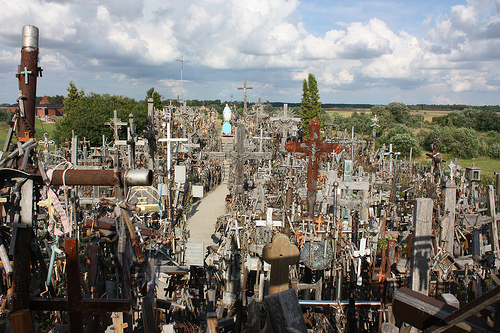Have you ever seen thousands of crosses in one place, like the Hill of Crosses?
- The Hill of Crosses is a 60 metre (200 feet) long hill, covering more than 4500 square metres (1.1 acre), north of the city of Šiauliai, in Lithuania, in northern Europe.
- The first crosses to be placed on the Hill of Crosses were probably erected there sometime after 1831, to remember dead relatives that were killed in a rebellion around that time.
- In 1900, 130 crosses existed on the Hill of Crosses, and now it is believed to have a collection of more than 200,000 crosses on site.
- The Hill of Crosses originally held a fortress that was destroyed, and now it attracts Catholic pilgrims, who bring, and leave there, crosses, crucifixes, carvings, rosaries, statues and the like.
- During its history, more than 6,200 crosses and other items have been destroyed on the Hill of Crosses in many demolition attempts by the Soviet government, but these were quickly replaced by new crosses each time.
Part of the Hill of Crosses
Image courtesy of Arian Zwegers/Flickr
- The crosses placed on the Hill of Crosses are symbolic of faith, love and sacrifice, and many prayers for peace over the centuries have been offered, amid religious and political unrest.
- Most crosses on the Hill of Crosses are made of wood, metal or plastic, and can be found in many different colours, shapes and sizes.
- In 1993, the Hill of Crosses was visited by Pope John Paul II, which brought attention to the site, and caused it to gain in popularity.
- Although entry onto the Hill of Crosses if free, parking at the base of the hill requires a fee.
- At the pope’s urging, a monastery was built a few hundred metres away from the Hill of Crosses, and it was consecrated in the year 2000.
Bibliography:
Hill of Crosses, 2002, Sanctuaries and Pilgrimage Sites, http://www.lcn.lt/en/bl/sventoves/kryziuk/
Hill of Crosses, 2013, Wikipedia, http://en.wikipedia.org/wiki/Hill_of_Crosses
History of the Hill of Crosses, 2012, HillofCrosses.com, http://www.hillofcrosses.com/hill-of-crosses-history.html







